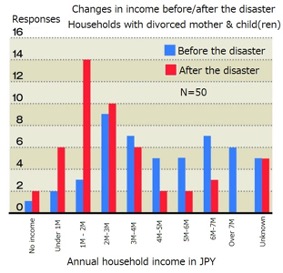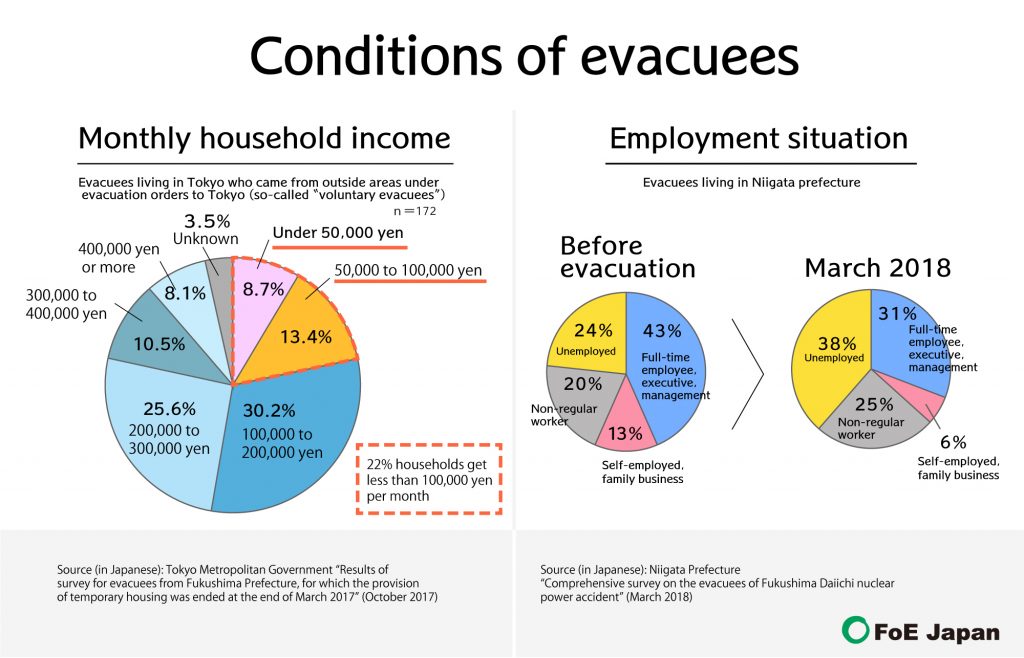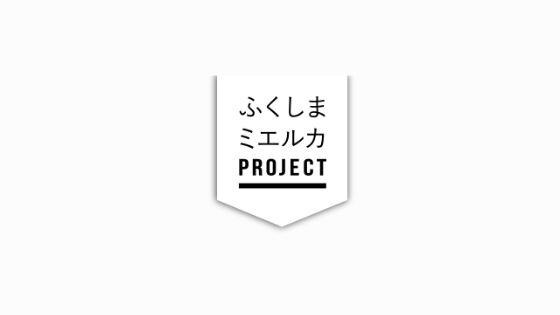“Right to evacuate” not respected
After the nuclear accident, the central government’s Nuclear Emergency Response Headquarters used a high level of radiation (20 mSv per year) as the criterion to determine which areas would be placed under evacuation orders. This decision did not reflect community concerns. In Ukraine, legislation was passed after the Chernobyl nuclear accident allowing affected residents in some zones to make their own decision on whether to remain or evacuate. But no such zones were created in the case of Japan. Many evacuees who lived outside the government-designated areas under evacuation orders ended up evacuating “voluntarily” (of their own accord). Thus, they were deemed to be ineligible for compensation. In some areas of the disaster-affected Nakadori area, such as the cities of Fukushima, Date, Nihonmatsu, and Koriyama, the radioactive contamination levels were as high as in areas that had been placed under evacuation orders. Some residents were unable to evacuate even if they wanted to, due to economic reasons or family circumstances.
In 2012, the Act on Assistance for Children and Nuclear Disaster Victims was passed unanimously by the national Diet. The Act states that “the radiation risks to human health from radioactive substances are not sufficiently known scientifically” (Article 1) and elucidates the national government’s “social responsibility for having promoted nuclear policies” (Article 3). The Act goes on to state that the national government is to provide medical and relocation assistance, as well as assistance to secure housing, employment, and recuperation where people resettle, so that victims can make their own decisions about housing, evacuation, and return. It specifies areas where people are eligible for assistance as “areas where annual dosage is below 20 mSv but above a certain level” (Article 8, paragraph 1).
Despite this legislation, assistance based on the Act has only been provided for a small fraction of all disaster victims.
Housing assistance programs terminated
Many evacuees from the nuclear accident received assistance under what is known as a “quasi-temporary housing” program, based on the Disaster Relief Act. The provision of relief for some 26,000 residents covered under this Act who were evacuees from the areas not designated as evacuation zones (so-called “voluntary” evacuees) was terminated in March 2017. Even so, nearly 80% of those evacuees chose to continue living as evacuees outside Fukushima Prefecture.[1] However, the meager housing assistance for low income persons also ended in March 2019.
Also, in March 2019, the provision of housing was terminated for evacuees from outside of “difficult-to-return” zones where evacuation orders had already been lifted, including Kawamata, Kawauchi, Odaka Ward in Minamisoma, Katsurao, and Iitate. In March 2020, the provision of housing for evacuees from “difficult-to-return” zones was terminated in Tomioka, Namie, Katsurao, and Iitate.
COVID-19 pandemic wreaks more havoc
Many of the “voluntary” evacuees decided to evacuate from their homes to protect their children and families, even though they knew they would receive no compensation or assistance. A small amount of compensation was eventually approved in December 2011, but it was far from covering the costs involved in evacuation. In many cases the evacuees would endure isolation and financial distress. Among them are elderly people, families with a handicapped family member, and single mothers, with no one to rely on. Divorce rates are also high among evacuees.
According to a 2020 survey[2] of people who evacuated after the nuclear accident, conducted by a research group at the Institute of Disaster Area Revitalization, Regrowth and Governance at Kwansei Gakuin University, evacuation increased the proportion of temporary, part-time, and unemployed workers. This tendency is even more pronounced for the so-called “voluntary” evacuees. Evacuation has increased the number of cases of single-person households or only children living together. Divorces have risen, also increasing the numbers of mother-and-child evacuee households. One can see that the situation has become more difficult for evacuee households of divorced mothers with one or more children, based on the significant rise in households with incomes below 1 million yen (about US$9,000) and between 1 and 2 million yen (about US$9,000 to $18,000) (see graph).

Source: Institute of Disaster Area Revitalization, Regrowth and Governance, Kwansei Gakuin University, Evacuation and Displacement Study Group, “National survey of persons who evacuated due to the nuclear accident” (summary) latest version (November 2020), in Japanese.
The survey also showed that, while already facing many hardships, evacuees were now experiencing added difficulties due to the COVID-19 pandemic. About 60% of “voluntary” evacuees responded that they were being either “significantly” or “somewhat” affected by the pandemic. Twenty percent said their monthly income had dropped by more than 100,000 yen (about US$900), and 11.4% said they had lost their jobs. In some cases, respondents said that the families they left behind had told them they had no right to expect financial assistance because it had been their own decision to evacuate despite family opposition, and in some cases the head of the household was receiving financial assistance but not passing it on.
The Tokyo Metropolitan Government conducted a survey of “voluntary” evacuees for whom housing assistance ended in March 2017.[3] It reveals the economic hardships of people who had evacuated to Tokyo, with 22% of households having monthly income below 100,000 yen (about US$900), and more than half below 200,000 yen (about US$1,800). Also, 16.5% of evacuees in Tokyo said that they had no one to contact or talk to on a daily basis.
As a part of Niigata Prefecture’s evidence of the impacts of the nuclear accident on the lives of evacuees, it became clear that evacuation resulted in a decrease in formal employment, self-employment, and family business employment, and an increase in part time work, gig work, and unemployment.[4]
The review committee published a report in January 2021 confirming the actual state of evacuees. Among its findings: “Besides the long time living as evacuees, people have also experienced a variety of losses and disruptions, so it is not easy to restore their lives and relationships to what they were before the disaster.” “Evacuees are making many sacrifices, having lost employment, a sense of purpose, and relationships, etc. Isolation and dislocation are also causing mother-and-child evacuees to experience stress, as well as physical and mental disorders, etc. However, each household had taken action to evacuate as a result of its own rational decisions, so it is necessary to fully understand the choices they have made.” The report also points out that the “loss and weakening of ties with their communities” from which they evacuated are causing serious damage. Even for people who did not evacuate, the report says that “anxiety about radiation-related health hazards leads to risk-coping behavior and reduces quality of life.”
Evacuees who fall through the cracks and lose support face major hardships. To take responsibility for having been promoting nuclear power policies, the national government is called upon to monitor the condition of evacuees and to establish the proper legislation, programs and implementation systems to provide relief for them.

Calling for the “right to evacuate”
FoE Japan has been conducting a campaign to ensure that the voices of evacuees are heard, advocating for the right to compensation for “voluntary” evacuees. Since the Act on Assistance for Children and Nuclear Disaster Victims was passed in 2012, we have been advocating for systems and programs to ensure the voices of the evacuees are considered, to ensure that the legislation does not get watered down. We have also opposed the termination of housing support for evacuees, and conducted signature campaigns together with many evacuees and supporters. In July 2016, we helped establish the “Cooperation Center for 3.11” (in Japanese, “Hinan no Kyodo Center”), which provides consultation services for evacuees, collaborates with local governments, and makes proposals to the government, etc.
(Fukushima Today and Japan’s Energy Future 2021
Original publication March 2021)
[1]Documents from Fukushima Prefecture, Livelihood Section, April 2017. Similar findings were stated in the Niigata Prefecture report “Verification of impacts on evacuation living due to the Fukushima Daiichi Nuclear Accident” (January 2021, in Japanese).
[2]Institute of Disaster Area Revitalization, Regrowth and Governance, Kwansei Gakuin University, Evacuation and Displacement Study Group, “National survey of persons who evacuated due to the nuclear accident” (summary) latest version (November 2020), in Japanese.
[3]Results of questionnaire survey for evacuees from Fukushima whose temporary housing provision was terminated at the end of March 2017 (Tokyo Metropolitan Office, October 11, 2017). Respondents were evacuees from Fukushima Prefecture whose temporary housing provision was terminated at the end of March 2017 (629 households who lived in temporary housing units provided by Tokyo government, as of April 1, 2016) of which 570 households could be reached by postal mail and who had vacated temporary housing units provided by the Tokyo Metropolitan Government. The number of responses was 172 (response rate 30.2%).
[4]Documents from second meeting of Niigata Prefecture review committee (livelihood subcommittee) on health and livelihood impacts of nuclear plant accident (Dec. 23, 2017). Survey of 1,174 households and heads of households who evacuated to Niigata Prefecture and are there now, or evacuated there but are currently living in another prefecture, plus another 192 adults and 122 junior and high school students.

